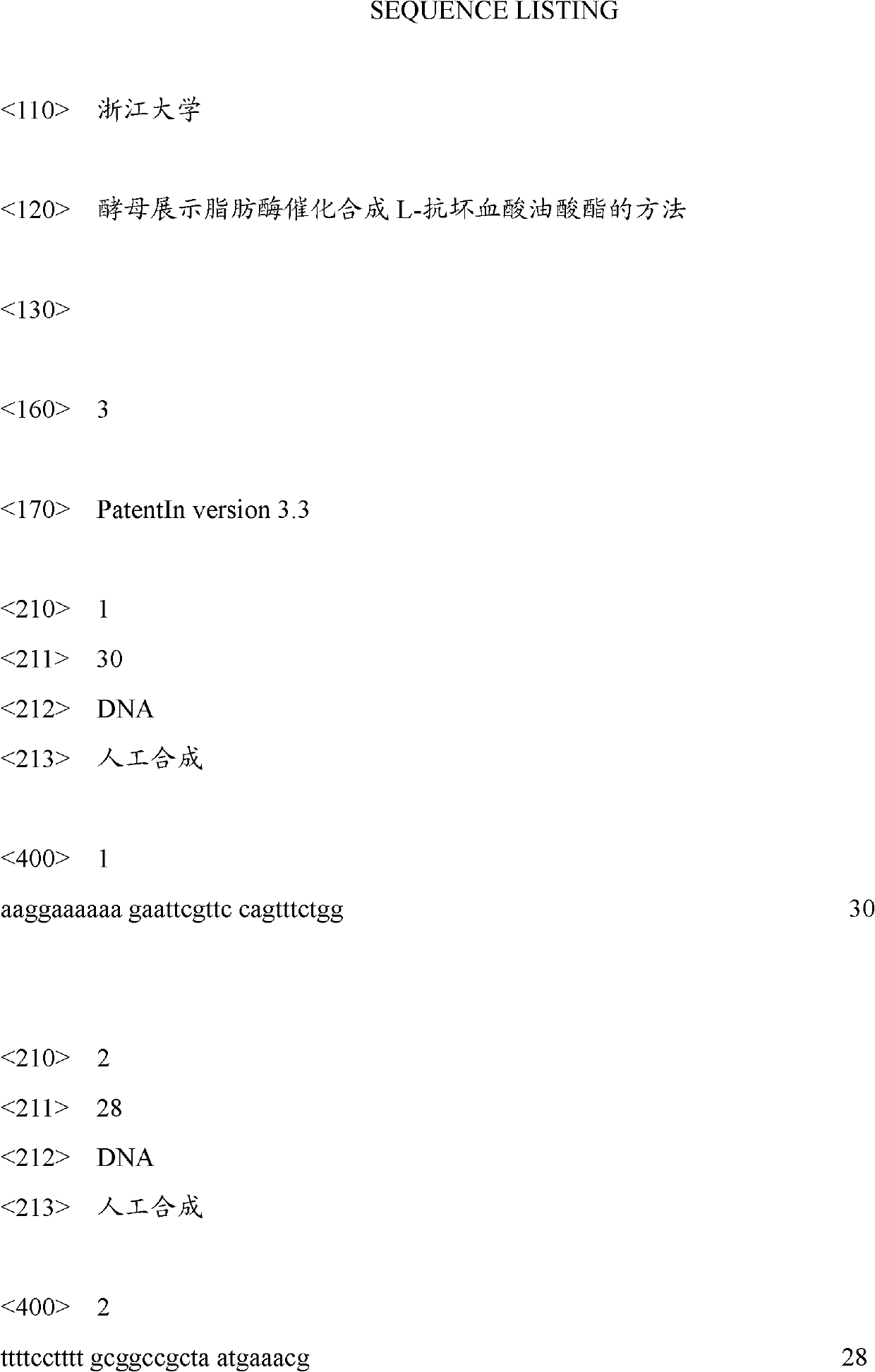Method for catalytically synthesizing L-ascorbyl oleate with yeast display lipase
A technology of acid oleate and lipase, which is applied in the field of yeast lipase-catalyzed synthesis of L-ascorbyl oleate, can solve the problems of limited commercial application, harsh conversion conditions, complex products, etc., and achieve the goal of improving operational stability Effect
- Summary
- Abstract
- Description
- Claims
- Application Information
AI Technical Summary
Problems solved by technology
Method used
Image
Examples
Embodiment 1
[0019] Example 1 Preparation of Yeast to Display Lipase
[0020] Synthesize the lipase gene (Genbank number: AF229435) of Rhizopus oryzae and the cell wall α-lectin gene of Pichia pastoris GS115 (Genbank number: M28164) by artificial synthesis, and add Connect the peptide sequence GSSGGSGGSGGSGGSGS(linker), and get the nucleotide sequence pro-ROL-linker-α-agglutinin after connection, and add EcoR I and Not I restriction sites at both ends of the sequence, where pro-ROL is the lipase gene , α-agglutinin is the cell wall α lectin gene.
[0021] Using the above artificially synthesized sequence as a template, PCR amplification was performed using the following primer pair,
[0022] Upstream primer: 5'-AAGGAAAAAAAGAATTCGTTCCAGTTTCTGG-3';
[0023] Downstream primer: 5'-TTTTCCTTTTGCGGCCGCTAATGAAACG-3'
[0024] The PCR reaction system is: 1 μl of template DNA, 0.5 μl of high-fidelity DNA polymerase, 0.4 μl of dNTP (50 mM), 0.5 μl of upstream and downstream primers, 5 μl of 10×PCR ...
example 1
[0029] Example 1 Take 0.176g of L-ascorbic acid and 1.27ml of oleic acid, put them into a ground-neck Erlenmeyer flask containing 10mL of tetrahydrofuran, mix and preheat for 10min, then add 0.5g of the above-mentioned yeast display lipase, fill with N 2 Sealed, placed in a 85-1 type magnetic stirrer and stirred to start the reaction, the rotating speed was 250 rpm, and the reaction temperature was kept at 45°C. After 6 hours of reaction, 0.5g molecular sieve (pore size less than 2nm) was added, and the reaction was continued for 12 hours. After that, the stirring was stopped. Centrifuge and precipitate to remove yeast display lipase and molecular sieves, take the supernatant and carry out rotary evaporation to remove tetrahydrofuran, wash with water for 3 times, add n-hexane and crystallize at 4°C to obtain L-ascorbyl oleate product, which can be dried and pulverized.
PUM
| Property | Measurement | Unit |
|---|---|---|
| pore size | aaaaa | aaaaa |
Abstract
Description
Claims
Application Information
 Login to View More
Login to View More - R&D
- Intellectual Property
- Life Sciences
- Materials
- Tech Scout
- Unparalleled Data Quality
- Higher Quality Content
- 60% Fewer Hallucinations
Browse by: Latest US Patents, China's latest patents, Technical Efficacy Thesaurus, Application Domain, Technology Topic, Popular Technical Reports.
© 2025 PatSnap. All rights reserved.Legal|Privacy policy|Modern Slavery Act Transparency Statement|Sitemap|About US| Contact US: help@patsnap.com


